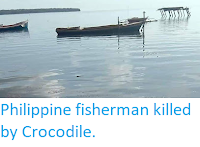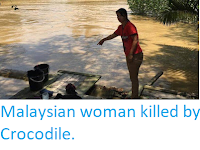An Tanzanian boy has died after being attacked by a Nile Crocodile, Crocodylus niloticus, on Lake Victoria. Magesa Biseko, 12, of Msuswiga in the Sengerema District of the Mwanza Region was swimming with friends on Friday 11 October 2019, when he was seized without warning by a large Crocodile and dragged away. His partially eaten remains were found on Sunday 13 October. This is the fifteenth known Crocodile-related fatality in Sengerema District since 2016, with the majority of those killed being children. A number of other attacks have not been fatal, but have still left their victims with life-changing injuries.
A Nile Crocodile, Crocodylus niloticus, on the shore of Lake Victoria in the Mwanza Region of Tanzania. Mwanza Guide.
Lake Victoria is home to a large population of Nile Crocodiles, Crocodylus niloticus,
which are considered to be a high risk to Humans in the area, with
frequent stories of fatal attacks in nations around the lake. A rising
Human population appears to be fuelling this conflict, with people
becoming more dependant on the lake for water, with many villagers calling for more governmental investment in
borehole-drilling projects, which will enable them to spend less time
close to the Crocodile-infested waters.
The approximate location of the 11 October 2019 Msuswiga Crocodile attack. Google Maps.
Conflicts between Humans and animals present a major challenge in
conservation work, particularly where animals are prone to attacking
Humans or livestock. The most common perpetrators of such attacks in
Africa are Crocodiles. Nile Crocodiles are particularly dangerous, with the largest males
reaching around five metres in length, and a diet that includes animals
such as Wildebeest, Connochaetes spp., and Buffalo, Syncerus caffer,
species which it requires considerable strength to subdue. Crocodiles
are extremely versatile in their environmental tolerances; they are
semi-aquatic, but dwell in a range of habitats from large, fast flowing
rivers to small ponds, and have quickly colonised Human-made
environments such as canals, dam lakes and even irrigation ditches,
creating extra opportunities for conflict with Humans.
Nile Crocodiles are considered to be of Least Concern under the terms of the International Union for the Conservation of Nature’s Red List of Threatened Species,
but are still protected in many countries, due to
historic hunting which decimated populations in many areas. However, the
rising number of attacks on Humans by the animals has led to calls for
regulated hunting to be introduced to control the population.
See also...
Follow Sciency Thoughts on Facebook.








